ZANÈ TWINS c.1992 - 2000
The final chapter in the production of Laverda motorcycles as we know them spans approximately the years 1992-2000. The downturn in the motorcycle industry in the early 80's forced Laverda - along with the majority of the Italian motorcycle industry - into receivership. The company went through a couple of iterations before ending up in 1990-ish under the control of the Zanini group.
Oil-cooled Models
A chassis was developed by Nico Bakker (though word is he was never paid) around the fuel injected 668cc engine derived from the 500 and the 1992 650 Sport was the result. A radical departure from most previous Laverdas for the international market, the bike was extremely small and light, it's strength being a superb chassis rather than high power output. It was quite a revelation and was received well by the press. But once again financial problems scuttled forward progress and Laverda under the Zanini group folded after production of just half a dozen bikes. Enter wealthy industrialist and bike enthusiast Francesco Tognon.
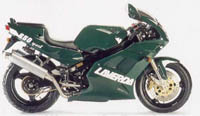 |
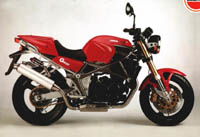 |
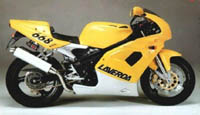 |
Tognon bought the remains of the company and set up a new factory in the neighboring town of Zanè, just 10km West of Breganze. If you're still in the dark as to why they're called "Zanès" then that be your answer. It took until 1994 to get the 650 Sport into proper production, and meanwhile some of the initiative had been lost as the competition evolved. But it was a very capable middleweight bike with sublime handling and an engine that allowed it to punch well above its weight.
And so followed a range of bikes built around this basic package, the 650 Formula was first with a slightly higher output engine and superior suspension and brakes. A tubular steel frame sharing the same overall dimensions was developed to allow different markets to be targeted and the first model to carry this was the 650 Ghost, a "naked" bike with an upright riding position. A reworked version of the 650 Sport was released called the 668 (note all 650 or 668 models shared the same 668cc capacity) which had slightly revised bodywork with twin round headlights replacing the euro-spec "letterbox" rectangular version or the slightly less appealing more square unit fitted to right-hand-drive market bikes. Various combinations on these themes continued until 2000, including the Diamante - a sport bike blending the steel tube frame with a half-fairing version of the 668 bodywork - and so on.
Watercooled Models
Meanwhile in around 1996 work began on a heavily revised engine featuring water cooling and a capacity of 750cc, the 750S was shown around 1997 and reached production soon after. Utilising much the same chassis as the 650, the 750S combined the superb dynamics of the 650s with more power and torque to make a truly great upper-middleweight machine with it's sights set firmly on the Ducati 748.
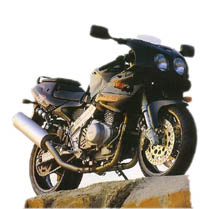 |
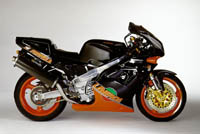 |
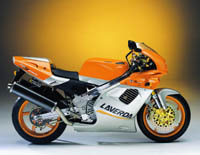 |
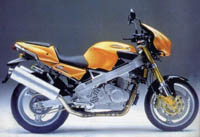 |
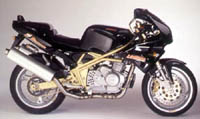 |
As with the oil-cooled range, both aluminium beam and steel tube frames were produced and a range of bikes were built around these two similar packages;
750 Carenata - Full fairing version of the 750S, aluminium frame, available in red or yellow.
750 Formula - Tuned 750S, with higher power output, floating disks, optioned up Paioli suspension etc. Black and orange.
750 Diamante - Half-faired 750S utilising the tubular steel frame.
750 Ghost Strike - Naked version, twin headlight bikini fairing, unlike the 650 Ghost this used the aluminium beam frame.
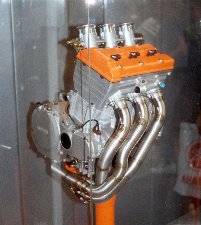 By 1998 the bikes were receiving generally good reviews and things were looking rosy. At this point the news that Laverda enthusiasts had all been waiting for began to leak - they were working on a new triple. Photos began to appear showing a thoroughly modern 12v water cooled triple, and it was even shown on a stand at the Milan show of 1999. This would become yet another blind alley for the marque, like so many other things never making it to the market. Rumours persist that designers of this engine were never paid (highly likely under the circumstances) and they took their designs to the re-launched Benelli company, and it eventually became the Tornado 900 and TnT 1130 engine. Although the two engines are externally somewhat different, the architecture of both are very similar indeed. Who knows?
By 1998 the bikes were receiving generally good reviews and things were looking rosy. At this point the news that Laverda enthusiasts had all been waiting for began to leak - they were working on a new triple. Photos began to appear showing a thoroughly modern 12v water cooled triple, and it was even shown on a stand at the Milan show of 1999. This would become yet another blind alley for the marque, like so many other things never making it to the market. Rumours persist that designers of this engine were never paid (highly likely under the circumstances) and they took their designs to the re-launched Benelli company, and it eventually became the Tornado 900 and TnT 1130 engine. Although the two engines are externally somewhat different, the architecture of both are very similar indeed. Who knows?
Although generally regarded as a joy to ride, these machines from Zanè were not without their problems. Issues ranged from minor things like relays that filled up with water, or fuel pumps whose pickup pipes fell off, up to and including incorrectly manufactured crankshaft, cylinder head and gearbox components necessitating major engine repairs - often under warranty. In the face of this it was only a matter of time before the operation once again found itself in financial difficulties and the company was sold to Aprilia in 2000, marking the end of the road for the designs that traced their roots to the Laverda company we knew and loved.

